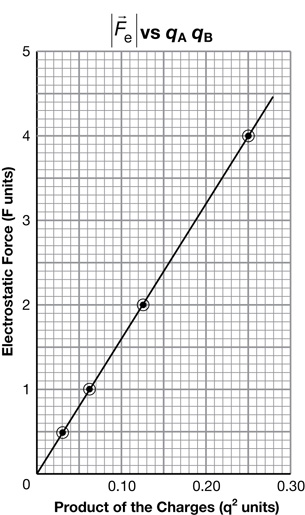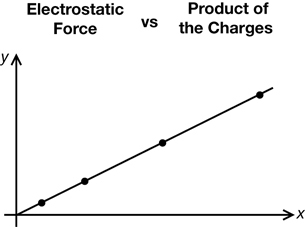Module 3
1. Module 3
1.14. Page 5
Module 3—Electrical Phenomena
Part B: How Electrostatic Force is Affected by Charge Strength (q)
Purpose
In this part of the lab you will examine sample data from Coulomb’s torsion balance experiment to determine how varying the charge on one sphere can influence the electrostatic force on the other.
Materials
The only material needed is sample data from a torsion balance-type experiment. This data is provided for you in this investigation. To determine these values Coulomb used his torsion balance.
Background Information
In part A Coulomb used a negatively charged rod to give sphere A and sphere B the same charge. He used a third neutral sphere called sphere C, which was otherwise identical to spheres A and B, to vary the amount of the charge on sphere B.
Each time sphere C was touched to sphere B, the original charge on sphere B was split between spheres B and C. After sphere C was removed, sphere B was left with only half of the charge that it had before touching sphere C. Grounding sphere C each time and repeating this process provided a method for varying the charge on sphere B. Sphere A’s charge remained the same throughout the process.
Procedure
The first three steps of the procedure are the same as part A. Step four is where the two procedures differ:
- Give sphere B an initial negative charge by touching it to a charged rubber rod that was rubbed with fur. Since Coulomb did not have a precise value for the charge on sphere B, he simply referred to this charge as qB.
- Touch sphere B momentarily to sphere A, which was initially neutral.
- With sphere A held stationary, place sphere B 2.0 cm away. Release sphere A, allowing the arm on the torsion balance to rotate. Measure the force acting on sphere A on the scale at the top of the torsion balance.
- Ground sphere C, which is identical in size to sphere A and sphere B, to give it a charge of zero. Touch it to sphere B and then remove it.
- Return sphere A to a distance 2.0 cm away from sphere B and release it, allowing the arm on the torsion balance to rotate. Measure the force again.
- Repeat the preceding two steps to observe how the new charges on sphere B affect the electrostatic force.
Observations
The following table summarizes these results.
Data
Charge on Sphere A |
Charge on Sphere B |
Product of the Charges |
Electrostatic Force on Sphere A |
|---|---|---|---|
|
|
|
4 |
|
|
|
2 |
|
|
|
1 |
|
|
|
|
Analysis
 Self-Check
Self-Check
SC 15. Plot a graph of the electrostatic force ![]() versus the product of the two charges (qA qB).
versus the product of the two charges (qA qB).
 Self-Check Answer
Self-Check Answer
SC 15. You could calculate the answer using pencil and paper, or you could calculate the answer using your graphing calculator.
Method 1: Pencil and Paper Approach

Method 2: Using a Graphing Calculator or a Computer
Data Entry:
q1q2 (q2 units) entered into L1
F (F units) entered into L2
Window Settings:
x: [0,0.25, 0.01]
y: [0,4,0.1]
Plot Setup:
To plot F (F units) versus q1q2 (q2 units), enter L2 for y and L1 for x.

If you used a graphing calculator or computer software to answer this question, be sure to communicate your answer in the proper format.
Part B Conclusion
Now that you have seen the observations and analyzed them by graphing you should be able to describe the relationship.
SC 16.
- Describe the shape of the graph that you plotted.
- Use the shape of the graph to state the mathematical relationship between the electrostatic force and the product of the two charges.
 Self-Check Answers
Self-Check Answers
SC 16.
- The result of graphing electrostatic force
 versus the product of the charges (qA qB) can be a straight line.
versus the product of the charges (qA qB) can be a straight line.
- The electrostatic force is directly proportional to the product of the charges. Mathematically, this can be written as
 .
.
Lab Conclusion
Now that you have completed Part A, you understand the relationship between the electrostatic force and the distance of separation. Since you have completed Part B, you also understand the relationship between the electrostatic force and the product of the charge. Now you need to combine your results to determine the equation that describes Coulomb’s law.
SC 17.Consider your conclusion for Part A and your conclusion for Part B. Based upon your results, state the mathematical relationship among the variables ![]() , qA, qB, and r.
, qA, qB, and r.
 Self-Check Answers
Self-Check Answers
SC 17. The electrostatic force ![]() is directly proportional to the product of the charges (qA qB) and inversely proportional to the square of the distance (r2).
is directly proportional to the product of the charges (qA qB) and inversely proportional to the square of the distance (r2).
Mathematically, this can be written as ![]()